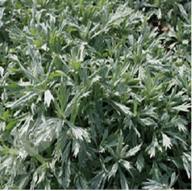
Plant of the Month, December, 2012
With its insignificant flowers, you’d never guess that Artemisia is a member of the Aster family. While flowers are not its strong point, beautiful, aromatic leaves make many of the 300 species of Artemisia favorites in the herb and flower gardens of Bath Garden Club members. Most Artemisia are native to North America, and all have grey or silver leaves. Some, most notably Tarragon, are grown as herbs and have extensive culinary uses.
For many years the only commonly available garden Artemisia was “Silver Mound” (A. Schmidtiana). Used extensively as an edging plant, this low mound of fine, silvery-green, feathered foliage grows only 12 inches tall. Like a well-clipped poodle, Silver Mound begs to be petted. Unfortunately, it also has the habit of either
opening outward or dying from the center by the end of the season. Happily, there are newly introduced edging and ground-cover plants such as “Silver Brocade” (A. Stelleriana). Only six inches high and 18 inches in spread, “Silver Brocade” has silvery-white foliage, somewhat more substantial than other Artemisias, but still beautifully lacy.
For taller garden plants Artemisia “Silver King” and “Silver Queen” have also been popular. Sporting lance-shaped silvery white leaves that grow green with age, both are hardy in Northeastern Ohio and grow approximately 30 inches tall. Almost as tall at 24 inches, “Valerie Finnis” has wide leaves and bright silver foliage. Another medium height Artemisia, “Powis Castle,” has proven unreliable in Northeastern Ohio winters.
Finally, if you have a wild area and like plants that provide fragrance, consider “Sweet Annie” (A. Annua). This homely self-seeding annual grows six feet in a season and perfumes the air when mowed or blown in the wind. Also called “Sweet Wormwood,” this Artemisia was used for centuries as a strewing herb on the dirt floors of peasant huts and the stone floors of castles.
Culturally, Artemisia are not fussy. They prefer full sun, “normal” amounts of water, and benefit from being trimmed back in Spring to provide more compact growth. The biggest risk for your Artemisia is too much water; Artemisia like a well-drained site and will not tolerate soggy soil.
For taller garden plants Artemisia “Silver King” and “Silver Queen” have also been popular. Sporting lance-shaped silvery white leaves that grow green with age, both are hardy in Northeastern Ohio and grow approximately 30 inches tall. Almost as tall at 24 inches, “Valerie Finnis” has wide leaves and bright silver foliage. Another medium height Artemisia, “Powis Castle,” has proven unreliable in Northeastern Ohio winters.
Finally, if you have a wild area and like plants that provide fragrance, consider “Sweet Annie” (A. Annua). This homely self-seeding annual grows six feet in a season and perfumes the air when mowed or blown in the wind. Also called “Sweet Wormwood,” this Artemisia was used for centuries as a strewing herb on the dirt floors of peasant huts and the stone floors of castles.
Culturally, Artemisia are not fussy. They prefer full sun, “normal” amounts of water, and benefit from being trimmed back in Spring to provide more compact growth. The biggest risk for your Artemisia is too much water; Artemisia like a well-drained site and will not tolerate soggy soil.

 RSS Feed
RSS Feed